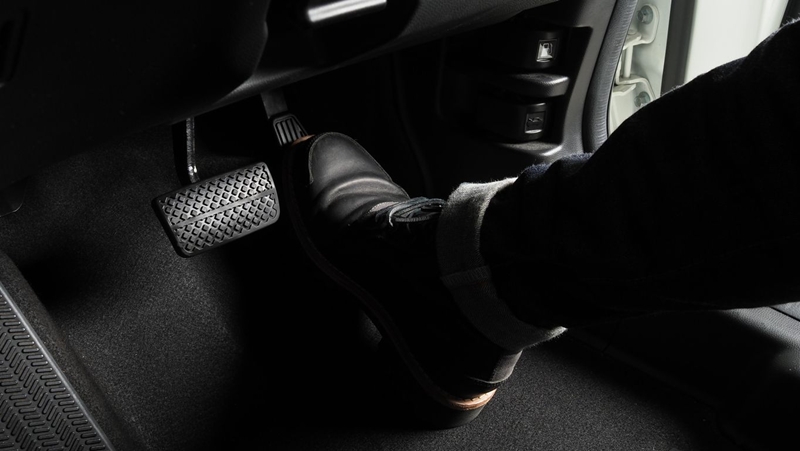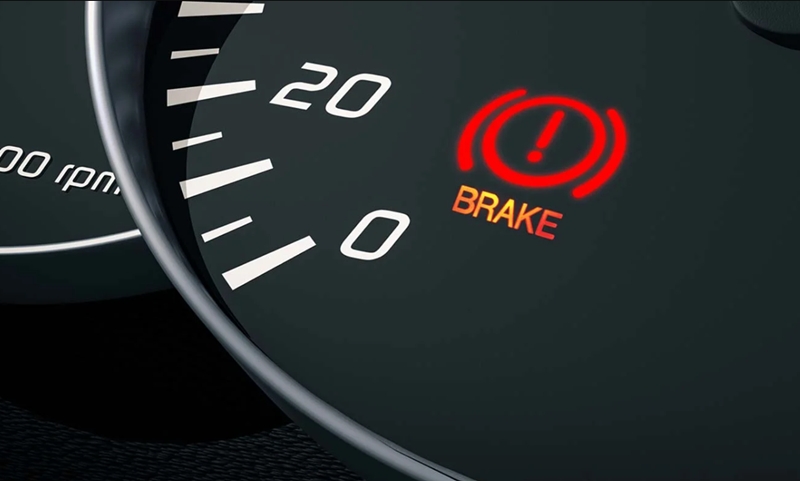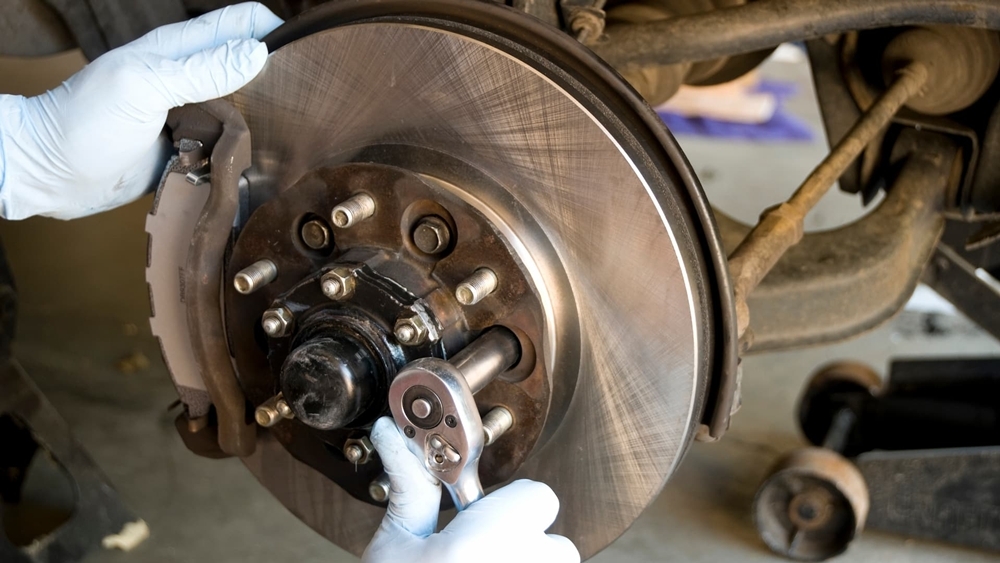Your Vehicle’s Most Critical Safety System Depends on Your Awareness
Every year, thousands of accidents occur due to brake failure that could have been prevented with early recognition of warning signs. Your brakes don’t fail overnight – they give you clear signals that something is wrong. The question is: do you know what to listen and look for?
This comprehensive guide breaks down brake warning signs into three critical categories: Urgent Brake Warning Signs (stop driving immediately), Moderate Brake Warning Signs (schedule repair soon), and Early Brake Warning Signs (monitor closely). From the terrifying moment when your brake pedal hits the floor to the subtle vibrations that hint at warped rotors, we cover every signal your brakes send when they need attention.

Table of Contents
What You’ll Learn:
- How to recognize immediate brake warning signs and emergencies that require stopping driving instantly
- The sounds, sensations, and visual cues that indicate developing brake problems
- Emergency protocols for brake failure while driving
- Essential maintenance tips to prevent brake issues before they start
- When to call mobile brake repair services vs. traditional shops
Also read: 5 Shocking Brake Pad Replacement Cost Factors That Could Save You Hundreds
11 Brake Warning Signs You Shouldn’t Ignore
Your vehicle’s brake system communicates through specific symptoms that indicate when components need attention. Recognizing these brake warning signs early can prevent dangerous situations and costly repairs. Here are the 11 most critical indicators every driver must know.
1. Brake Pedal Goes to the Floor
When your brake pedal travels completely to the floor without resistance, you’re experiencing one of the most serious symptoms possible. This condition indicates total brake system failure, often caused by brake fluid loss or master cylinder failure. If you encounter this problem, use emergency braking procedures immediately and stop driving.
2. High-Pitched Squealing Sounds
Squealing noises when braking represent common indicators that your brake pads are approaching replacement time. These sounds come from built-in wear indicators designed to alert you before damage occurs to rotors. While squealing doesn’t require immediate stopping, it indicates your brake pads need replacement within a few thousand miles.
3. Metal-on-Metal Grinding Noises
Grinding sounds create urgent brake warning signs showing your brake pads have worn completely through to the metal backing. This noise indicates metal components scraping together, potentially damaging expensive rotors and calipers. Grinding requires immediate professional attention to prevent further brake system damage.
4. Vehicle Pulls to One Side When Braking
When your car pulls strongly left or right during braking, this suggests uneven brake wear, stuck calipers, or contaminated brake fluid. Pulling affects your ability to stop straight and control your vehicle during emergency situations, making this a serious safety concern requiring prompt repair.
5. Brake Pedal Feels Spongy or Soft
A soft, spongy brake pedal indicates air in brake lines or brake fluid contamination. This condition means your brake system isn’t building proper hydraulic pressure, reducing braking effectiveness. Spongy pedals require immediate brake system bleeding or brake fluid replacement.
6. Brake Warning Light Stays On
A persistent red brake system light on your dashboard represents obvious brake warning signs of system problems. This indicator can signal low brake fluid, electrical issues, or parking brake engagement. Never ignore dashboard lights, as they signal your brake system isn’t functioning at full capacity.
7. Vibrating or Pulsing Brake Pedal
Brake pedal pulsation during normal braking indicates warped brake rotors or system irregularities. This symptom affects smooth braking and indicates rotors need resurfacing or replacement. Pulsing can worsen quickly, especially during heavy braking situations.
8. Increased Stopping Distance
When your vehicle requires noticeably more distance to stop completely, this indicates deteriorating brake pad material or system efficiency. Gradually increasing stopping distances represent declining braking power that needs professional evaluation before becoming dangerous.
9. Brake Fluid Leaks Under Vehicle
Brake fluid puddles under your parked car signal serious leaks from brake lines, calipers, or the master cylinder. Fresh brake fluid appears clear to amber, while old fluid shows darker signs of contamination. Any brake fluid leaks require immediate attention to maintain safe braking ability.
10. Burning Smell During or After Braking
A burning odor when braking indicates overheated brake components, often from stuck calipers or extremely worn brake pads. This smell signals excessive heat buildup that can cause brake fade or component failure. Burning odors require immediate inspection and cooling down.
11. Steering Wheel Vibration When Braking
Steering wheel vibration during braking represents warped front rotors or uneven brake pad wear. This symptom affects your steering control and indicates front brake components need attention. While not immediately dangerous, steering vibration can progress to more serious brake system problems.
How to Respond to These Symptoms
Immediate Action Required (Signs 1, 3, 6, 9, 10): Pull over safely, stop driving, and arrange professional brake service or towing.
Schedule Repair This Week (Signs 4, 5, 7): Continue driving carefully while arranging brake system inspection and repair within a few days.
Plan Service Soon (Signs 2, 8, 11): Monitor these symptoms closely and schedule brake maintenance within 1-2 weeks or at your next service appointment.
Why You Shouldn’t Ignore These Symptoms
Ignoring brake problems leads to progressively more dangerous and expensive issues. What starts as simple brake pad replacement can escalate to complete brake system reconstruction if symptoms are dismissed. More importantly, these brake warning signs exist to prevent accidents that could endanger you, your passengers, and other drivers.
Every one of these indicators represents your vehicle’s attempt to communicate brake system needs before complete failure occurs. Professional brake technicians can diagnose the specific cause behind your symptoms and recommend appropriate repairs to restore safe braking performance.
Don’t wait until it’s too late. Brake problems never improve on their own – they only get more dangerous and more expensive. Whether you’re hearing that first squeal of worn brake pads or feeling unusual vibrations through your steering wheel, this guide helps you understand what your vehicle is trying to tell you and how urgently you need to act.
Your safety and the safety of others on the road depends on your brakes working perfectly when you need them most. Learn the warning signs that could save your life.

Vehicle-Specific Brake Warning Signs Information
Different vehicle types display unique characteristics when developing brake problems. Understanding how brake warning signs manifest across various vehicle categories helps drivers recognize issues specific to their particular automobile, truck, or specialty vehicle.
Older Vehicles vs. Modern Cars
Pre-2000 Vehicle Brake Warning Signs Older vehicles typically exhibit more pronounced brake warning signs due to less sophisticated braking systems. These cars often display obvious mechanical symptoms like severe brake pedal travel, loud grinding noises, and visible brake fluid leaks. Brake warning signs in older vehicles frequently include manual brake system failures where power assist components malfunction, creating harder pedal pressure requirements.
Modern Vehicle Brake Warning Signs Contemporary vehicles feature advanced brake systems that produce subtler brake warning signs initially. Electronic brake distribution systems may mask early brake warning signs, making problems less obvious until they become serious. Modern brake warning signs often appear first as dashboard alerts, electronic stability control activation, or slight changes in brake pedal feel that older vehicles wouldn’t detect.
Electric and Hybrid Vehicle Considerations
Regenerative Braking System Warning Signs Electric and hybrid vehicles use regenerative braking systems that create unique brake warning signs different from traditional vehicles. These brake warning signs include inconsistent braking feel when transitioning between regenerative and friction braking, unusual brake pedal behavior during battery charging cycles, and electronic system error messages related to brake energy recovery.
Hybrid Vehicle Brake Warning Signs Hybrid vehicles often display brake warning signs related to the complex interaction between electric motors and traditional brake systems. Common brake warning signs in hybrids include delayed brake response when switching between driving modes, brake system warning lights related to hybrid battery status, and unusual brake pedal feedback during regenerative braking operation.
Truck and SUV Brake Characteristics
Heavy Vehicle Brake Warning Signs Trucks and large SUVs exhibit brake warning signs that differ significantly from passenger cars due to increased weight and brake system demands. These vehicles show brake warning signs like brake fade during mountain driving, uneven brake wear between front and rear axles, and brake overheating symptoms during towing operations.
Commercial Vehicle Considerations Work trucks and commercial vehicles experience brake warning signs related to heavy-duty usage patterns. Professional drivers should recognize brake warning signs including air brake system alerts, brake temperature warnings, and load-related brake performance changes that indicate brake system stress beyond normal passenger vehicle operation.
Luxury Vehicle Advanced Systems
Electronic Brake System Warning Signs Luxury vehicles equipped with advanced brake systems display sophisticated brake warning signs through multiple electronic interfaces. These brake warning signs include brake assist activation indicators, electronic brake force distribution alerts, and brake system diagnostic messages that require specialized diagnostic equipment to interpret properly.
Performance Vehicle Brake Considerations High-performance vehicles often exhibit brake warning signs related to aggressive driving conditions and specialized brake components. Performance car brake warning signs include brake cooling system alerts, track-mode brake temperature warnings, and brake pad compound indicators that signal when racing brake pads need replacement.
Age-Related Brake System Differences
New Vehicle Break-In Period Brand-new vehicles may display normal brake warning signs during the break-in period that shouldn’t cause concern. These temporary brake warning signs include slight brake noise during initial pad bedding, minor brake dust accumulation, and brake pedal feel changes as components settle into normal operation patterns.
High-Mileage Vehicle Considerations Vehicles with over 100,000 miles often develop brake warning signs related to overall system aging. High-mileage brake warning signs typically include brake fluid contamination, brake line corrosion, brake caliper seal deterioration, and brake system component wear that requires comprehensive brake system evaluation rather than simple component replacement.
Climate and Regional Factors
Cold Climate Brake Warning Signs Vehicles operated in cold climates experience unique brake warning signs related to temperature extremes and road salt exposure. Winter brake warning signs include brake line corrosion acceleration, brake fluid moisture contamination, brake caliper freezing symptoms, and brake pad performance changes in sub-zero temperatures.
Hot Climate Considerations Desert and hot climate operation creates specific brake warning signs including brake fluid boiling symptoms, brake fade during extended mountain descents, brake component expansion issues, and accelerated brake pad wear due to consistent high-temperature operation.
Specialty Vehicle Categories
Sports Car Brake Systems Sports cars feature high-performance brake systems that exhibit unique brake warning signs requiring specialized attention. Racing-inspired brake warning signs include brake cooling duct blockage indicators, performance brake pad glazing symptoms, and brake rotor heat cycling damage that affects braking consistency.
Fleet Vehicle Monitoring Commercial fleet vehicles require systematic brake warning signs monitoring due to varied driving conditions and multiple operators. Fleet brake warning signs include accelerated brake wear patterns, brake system abuse indicators, and maintenance scheduling alerts based on brake performance data rather than traditional mileage intervals.
Understanding these vehicle-specific brake warning signs helps drivers recognize problems early and communicate effectively with brake service professionals about their particular vehicle’s brake system needs and operating conditions.

FAQ: Brake Warning Signs
-
How often should I check my brakes for warning signs?
You should pay attention to brake performance every time you drive. Conduct a more thorough inspection monthly, checking brake fluid levels and listening for unusual sounds. Professional brake inspections should occur every 12,000 miles or during regular oil changes.
-
What’s the difference between squealing and grinding brake noises?
Squealing typically indicates worn brake pads that still have some material left but need replacement soon. Grinding means the pads are completely worn and metal is scraping against metal, potentially damaging expensive rotors. Grinding requires immediate attention.
-
Can I drive with a spongy brake pedal?
A spongy brake pedal indicates air in the brake lines or low brake fluid, both serious safety issues. While you might still have some braking ability, this condition can worsen quickly. Check your brake fluid immediately and avoid driving until the issue is resolved.
-
How do I know if my brake fluid is low or contaminated?
Check the brake fluid reservoir under your hood (consult your owner’s manual for location). Fluid should be clear to light amber and between the minimum and maximum lines. Dark, thick, or contaminated fluid needs immediate replacement.
-
What should I do if my brakes fail while driving?
Stay calm, pump the brake pedal rapidly, gradually apply the parking brake, downshift to a lower gear, look for a safe place to stop, turn on hazard lights, and call for emergency assistance immediately.
-
How much does it typically cost to fix brake problems?
Costs vary widely depending on the issue. Brake pad replacement typically ranges from $100-300 per axle, while rotor replacement can cost $200-500 per axle. Complete brake system repairs can cost $500-1,500 or more. Early intervention always costs less than waiting.
-
Is it safe to drive to the repair shop with brake problems?
This depends on the severity of the problem. If you experience complete brake failure, spongy pedals, or brake fluid leaks, do not drive. For squealing or mild grinding, you may drive carefully to a nearby shop, but don’t delay the repair.
-
How long do brake pads typically last?
Brake pad lifespan varies based on driving habits, vehicle type, and pad quality. Typically, brake pads last 25,000-70,000 miles. City driving, frequent stopping, and aggressive braking reduce pad life significantly.
-
Why does my car pull to one side when braking?
This usually indicates uneven brake wear, a stuck brake caliper, or brake fluid contamination on one side. This condition affects your ability to stop straight and can be dangerous during emergency braking situations.
Need a mechanic? Find one on the Mobile Mechanic Directory
Final Thoughts
Understanding brake warning signs isn’t just about vehicle maintenance – it’s about protecting yourself, your passengers, and everyone else on the road. The moment you notice any unusual brake behavior, whether it’s a subtle change in pedal feel or an obvious grinding noise, you’re receiving a critical message from your vehicle’s most important safety system.
Every brake warning signs guide emphasizes one fundamental truth: brake problems never resolve themselves. What starts as a minor squeal can quickly escalate to complete brake failure if ignored. The cost difference between early brake pad replacement and major brake system repair can be hundreds or even thousands of dollars, but more importantly, the safety implications are immeasurable.
Modern vehicles are equipped with sophisticated brake systems designed to give you multiple warnings before complete failure occurs. By learning to recognize these brake warning signs early, you’re taking control of your safety and making informed decisions about when to seek professional help. Remember that mobile brake repair services have made it easier than ever to address brake issues promptly, often at your home or workplace.
The next time you’re behind the wheel, pay attention to how your brakes feel and sound during normal operation. This baseline knowledge will help you immediately recognize when something changes. Your brakes are speaking to you constantly – the question is whether you’re listening to what they’re trying to say about your safety.





